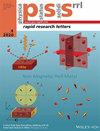掺铒 Ta2O5 薄膜硅基发光器件的电致发光性能
IF 2.5
4区 物理与天体物理
Q3 MATERIALS SCIENCE, MULTIDISCIPLINARY
引用次数: 0
摘要
本研究报告了基于掺铒 Ta2O5(Ta2O5:Er)/SiO2/Si 结构的发光器件(LED)发出的可见光和近红外电致发光(EL)。其中,∽10 nm 厚的 SiO2 中间层是形成热电子的能量高原,在与 Si 相连的负电压下,热电子最初通过阱辅助隧道机制从 Si 传输。热电子撞击并激发掺杂在 Ta2O5 主成分中的 Er3+ 离子,从而导致上述 LED 发出与 Er 有关的 EL。研究发现,750 °C退火的Ta2O5:Er薄膜可用作发光元件。尽管随着掺铒含量从标称的 0.75、1.5 到 3 摩尔%的增加,Ta2O5:Er 薄膜发出的与铒有关的光致发光依次变强,但标称掺铒含量为 1.5 摩尔%而不是 3 摩尔%的 Ta2O5:Er 薄膜使 LED 显示出最强的 EL。根据电致发光寿命的测量结果和结构特征,我们认为,Er3+离子之间非辐射性相互作用的增强,以及标称的 3 摩尔% Er 掺杂造成的 Ta2O5 主基的大量非晶性,是上述电致发光减弱的原因。本文受版权保护。本文章由计算机程序翻译,如有差异,请以英文原文为准。
Electroluminescence from Silicon‐Based Light‐Emitting Devices with Erbium‐Doped Ta2O5 Films
The visible and near‐infrared electroluminescence (EL) from the light‐emitting device (LED) based on the erbium (Er)‐doped Ta2 O5 (Ta2 O5 :Er)/SiO2 /Si structure is reported in this study. Wherein, an ∽10 nm thick SiO2 intermediate layer serves as an energy plateau for forming hot electrons, which initially transport from Si via trap‐assisted tunneling mechanism under sufficiently forward bias with the negative voltage connecting with Si. The hot electrons impact‐excite the Er3+ ions incorporated into the Ta2 O5 host, leading to the Er‐related EL from the aforementioned LED. It is found that the 750 °C ‐ annealed Ta2 O5 :Er films are desirable to act as the light‐emitting component. Despite that the Er‐related photoluminescence from the Ta2 O5 :Er film becomes stronger in turn with the Er‐doping content increasing from nominal 0.75, 1.5 to 3 mol %, it is the Ta2 O5 :Er film with Er‐doping content of nominal 1.5 mol % rather than 3 mol % that enables the LED to exhibit the strongest EL. Based on the EL lifetime measurement and the structural characterizations, it is believed that the enhanced non‐radiative interactions among the Er3+ ions and the substantial amorphousness of Ta2 O5 host caused by the nominal 3 mol % Er‐doping are responsible for the weakened EL as mentioned above.This article is protected by copyright. All rights reserved.
求助全文
通过发布文献求助,成功后即可免费获取论文全文。
去求助
来源期刊

Physica Status Solidi-Rapid Research Letters
物理-材料科学:综合
CiteScore
5.20
自引率
3.60%
发文量
208
审稿时长
1.4 months
期刊介绍:
Physica status solidi (RRL) - Rapid Research Letters was designed to offer extremely fast publication times and is currently one of the fastest double peer-reviewed publication media in solid state and materials physics. Average times are 11 days from submission to first editorial decision, and 12 days from acceptance to online publication. It communicates important findings with a high degree of novelty and need for express publication, as well as other results of immediate interest to the solid-state physics and materials science community. Published Letters require approval by at least two independent reviewers.
The journal covers topics such as preparation, structure and simulation of advanced materials, theoretical and experimental investigations of the atomistic and electronic structure, optical, magnetic, superconducting, ferroelectric and other properties of solids, nanostructures and low-dimensional systems as well as device applications. Rapid Research Letters particularly invites papers from interdisciplinary and emerging new areas of research.
 求助内容:
求助内容: 应助结果提醒方式:
应助结果提醒方式:


